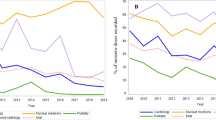Abstract
The data analysis of occupationally exposed medical workers in Nuclear Medicine (NM), Radiotherapy (RT) and Diagnostic Radiology (DR) at the Institute of Nuclear Medicine and Oncology (INMOL), Pakistan is presented for the time interval (2007–2011). The whole-body exposure doses of the workers were measured by using the Film Badge Dosimetry technique. The annual average effective doses in NM, RT and DR have been found well below the permissible annual limit of 20 mSv (averaged over a period of 5 consecutive years), with no over-exposure detected. This declining trend of annual average effective dose is the consequence of improved radiation protection practices at INMOL during the recent years.

Similar content being viewed by others
References
Course BM (1998) Radionuclides for bone palliation. Appl Radiat Isot 49:275–356
IAEA (1994) International basic safety standard/or protection against ionizing radiation and for the safety of radiation sources. IAEA Safety Series No: 115–1
ICRR (1991), 1990 Recommendations of the International Commission on Radiological Protection (ICRP). ICRP Publication No: 60, 21(1–3)
Cember H (2004) Introduction to health physics, 3rd edn. Health Physics Instrumentation, McGraw-Hill Inc., pp 365–369
William HH (1994) Radiation protection, Lewis publishers, London. ISBN: 0-87371.996-4
Holm NW, Roger RJ (1970) Manual on radiation dosimetry. Marcel Dekker Inc., New York
International Atomic Energy Agency (IAEA) (2000). Safety series calibration of radiation protection instruments. Safety Report Series No. 16, pp 153
United Nation Scientific Committee on the Effects of Atomic Radiation (UNSCEAR) (2000) Occupational radiation doses. UNSCEAR Report: 20
Wu W, Zhang W, Cheng R, Zhang L (2006) Occupational exposures of Chinese medical radiation workers in 1986–2000. Radiat Proct Dosim 117(4):440–443
Valuckas KR, Atkocius V, Samerdokiene V (2007) Occupational exposure of medical radiation workers in Lithuania, 1991–2003. Acta Med Lituanica 14(3):155–159
Kamenopoulou V, Drikos G, Dimitriou P (2000) Occupational exposure to ionising radiation in Greece (1994–1998). Radiat Prot Dosim. 91(4):385–389
United Nations Scientific Committee on the Effects of Atomic Radiation (UNSCEAR) (2008) Sources and effects of ionizing radiation. UNSCEAR 2008 Report: 01
Wrixon AD (2008) New ICRP recommendatios. J Radiol Prot 28(2):161
Author information
Authors and Affiliations
Corresponding author
Rights and permissions
About this article
Cite this article
Masood, K., Ahmad, M., Zafar, J. et al. Assessment of Occupational Exposure Among Pakistani Medical Staff During 2007–2011. Australas Phys Eng Sci Med 35, 297–300 (2012). https://doi.org/10.1007/s13246-012-0156-y
Received:
Accepted:
Published:
Issue Date:
DOI: https://doi.org/10.1007/s13246-012-0156-y




